10 Endangered species in Japan
Japanese Giant Salamander (Andrias japonicus), Japanese Crested Ibis (Nipponia nippon), Iriomote Cat (Prionailurus bengalensis iriomotensis)
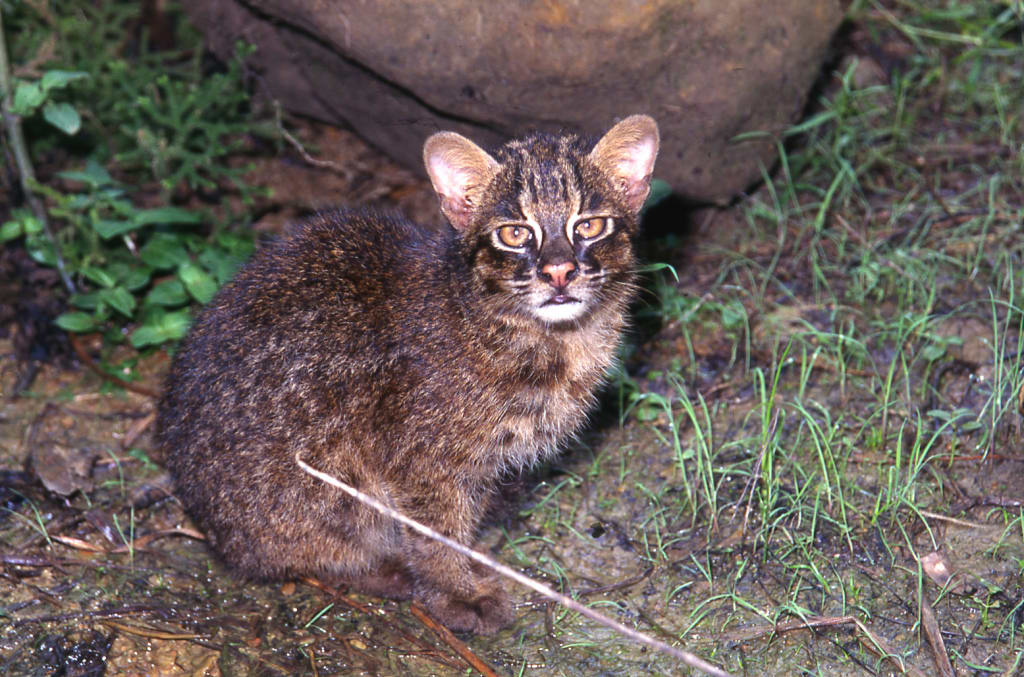
1., Amami Rabbit (Pentalagus furnessi):
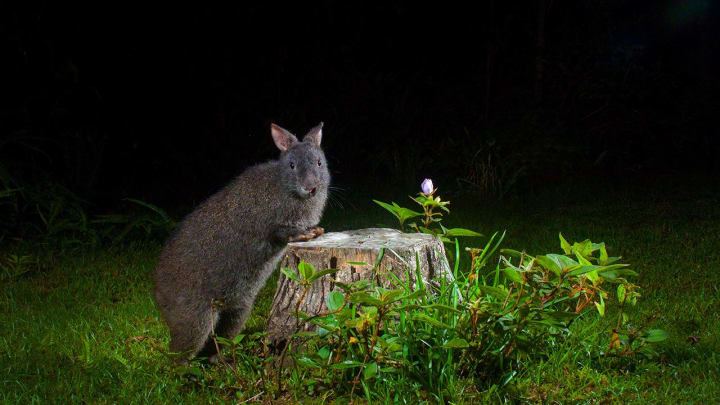
The Amami Rabbit (Pentalagus furnessi) is a rare and endangered rabbit species endemic to the Amami Islands in southern Japan. It is also known as the Amami Kanoko or Amami-no-Kuro-Usagi in Japanese. This unique rabbit is one of the most endangered mammals in Japan and is considered a national natural monument.
Physical Description:
The Amami Rabbit is a medium-sized rabbit with a stout build. It has a body length of approximately 40 to 50 centimeters (16 to 20 inches) and weighs around 2 to 2.5 kilograms (4.4 to 5.5 pounds). The species exhibits sexual dimorphism, with females being slightly larger than males.
The rabbit's fur is dense, soft, and plush, providing excellent insulation against the island's subtropical climate. The upperparts of the Amami Rabbit are dark brown or black, while the underparts are lighter, often displaying a reddish-brown coloration. The species has round, dark eyes and relatively short ears compared to other rabbit species.
Habitat and Distribution:
The Amami Rabbit is native to the Amami Islands, which are part of the Ryukyu Islands chain located between Kyushu and Okinawa in southern Japan. Its natural habitat consists of dense subtropical forests, dominated by broad-leaved evergreen trees such as Castanopsis sieboldii and Machilus thunbergii.
Behavior and Diet:
Amami Rabbits are primarily crepuscular and nocturnal, being most active during dawn and dusk. They are solitary animals and highly territorial, with each individual maintaining its own home range. These rabbits are shy and elusive, making it challenging to observe them in the wild.
The diet of the Amami Rabbit mainly consists of leaves, grasses, bark, and various plant materials. It has a specialized digestive system that allows it to efficiently process the fiber-rich diet of the forest. The species is known for its ability to consume large quantities of toxic leaves that are unpalatable to many other herbivores.
Conservation Status and Threats:
The Amami Rabbit is listed as critically endangered by the International Union for Conservation of Nature (IUCN). It is one of the rarest rabbit species globally, with a severely fragmented population. As of the latest assessments, the estimated population size is less than 2,000 individuals.
The primary threats to the Amami Rabbit's survival are habitat loss and degradation. Deforestation, agriculture, and urbanization have resulted in the loss and fragmentation of its natural habitat. This has led to a decline in suitable areas for the rabbit to live and forage.
Invasive species, particularly feral cats and mongoose, pose a significant threat to the Amami Rabbit. Predation by these introduced predators has resulted in increased mortality rates for the species. Additionally, climate change, disease, and potential genetic bottlenecks due to the small population size further exacerbate the conservation challenges.
Conservation Efforts:
Efforts are being made to conserve the Amami Rabbit and its habitat. The establishment of protected areas, such as the Amami Gunto Quasi-National Park and the Amami Guntō Wildlife Protection Area, has contributed to habitat preservation and restoration.
Conservation initiatives involve research and monitoring programs to study the population dynamics, behavior, and ecological requirements of the Amami Rabbit. Captive breeding and reintroduction programs have been implemented to augment wild populations and reduce the risk of extinction.
Public awareness campaigns, education, and community engagement play an essential role in promoting the conservation of the Amami Rabbit. Collaborative efforts between government agencies, conservation organizations, researchers, and local communities are essential for the long-term survival of this critically endangered rabbit species.
2., Iriomote Cat (Prionailurus bengalensis iriomotensis):
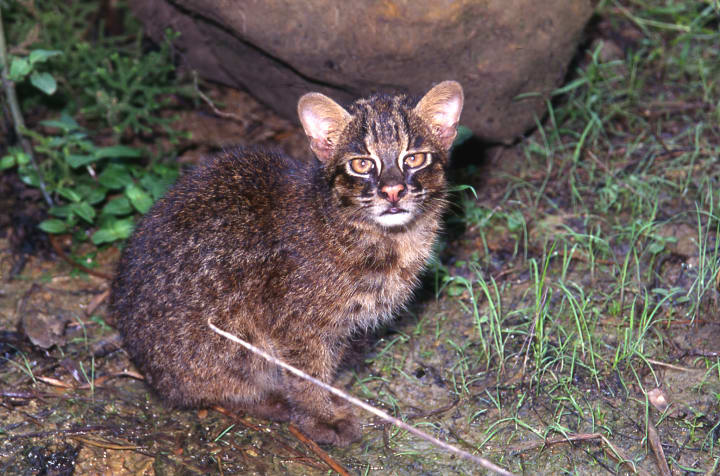
The Iriomote Cat (Prionailurus bengalensis iriomotensis) is a subspecies of the leopard cat and is endemic to the island of Iriomote in the Yaeyama Islands of Okinawa, Japan. It is one of the rarest and most endangered wild cats in the world, with a population estimated to be fewer than 100 individuals. The Iriomote Cat is recognized as a national natural monument of Japan.
Physical Description:
The Iriomote Cat is a small to medium-sized cat, similar in size to a domestic cat. It has a slender and agile body, measuring around 60 to 70 centimeters (24 to 28 inches) in length, including the tail, and weighs approximately 2 to 3 kilograms (4.4 to 6.6 pounds). It has short legs and a relatively long tail.
The fur of the Iriomote Cat is characterized by a yellow-brown or reddish-brown background color with distinct dark spots or stripes. Its coat pattern helps it blend in with the dense vegetation of its habitat. The ears are rounded with a black tuft of hair on the tip, and the eyes are large and yellowish-brown.
Habitat and Distribution:
The Iriomote Cat is restricted to the island of Iriomote, which is the second-largest of the Yaeyama Islands in southwestern Japan. It inhabits a variety of habitats on the island, including dense subtropical forests, mangroves, riverbanks, and coastal areas. It is particularly associated with forested regions near water sources.
Behavior and Diet:
The Iriomote Cat is predominantly nocturnal and is known for its elusive and secretive nature. It is an excellent climber and swimmer, often traversing trees and swimming across rivers in search of prey. The cat is also a skilled hunter, feeding on a variety of small mammals, birds, reptiles, amphibians, and insects.
Due to its elusive behavior, little is known about the reproduction and social structure of the Iriomote Cat. It is believed to be a solitary and territorial species, with individuals marking their territories through scent marking.
Conservation Status and Threats:
The Iriomote Cat is listed as critically endangered by the International Union for Conservation of Nature (IUCN) and is considered one of the most endangered wild cats in the world. The small population size, restricted range, and ongoing threats contribute to its vulnerable status.
The primary threats to the Iriomote Cat's survival include habitat loss and fragmentation, predation by introduced species, roadkill, and the potential risk of diseases. Deforestation, agricultural expansion, and urbanization have resulted in the loss and degradation of its natural habitat, reducing the available resources and increasing human-wildlife conflicts.
Conservation Efforts:
Efforts are underway to protect and conserve the Iriomote Cat and its habitat. The Iriomote National Park, established in 1972, encompasses a significant portion of the cat's range and provides some level of protection.
Conservation initiatives involve habitat restoration, reforestation, and the implementation of measures to reduce human impacts on the species, such as establishing wildlife corridors and creating buffer zones around core areas. Research and monitoring programs are conducted to gather data on population dynamics, behavior, and ecological requirements.
Public awareness campaigns, education, and community engagement are vital for promoting the conservation of the Iriomote Cat. Collaboration between government agencies, conservation organizations, researchers, and local communities is crucial to implementing effective conservation strategies, mitigating threats, and ensuring the long-term survival of this critically endangered wild cat species.
3., Okinawa Rail (Gallirallus okinawae):
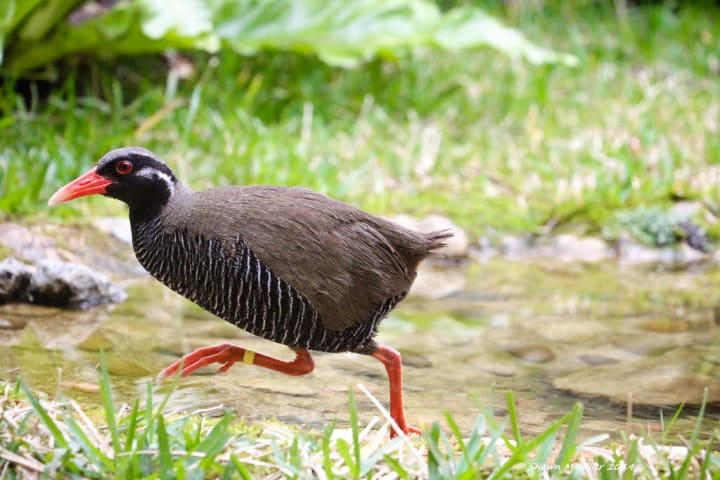
The Okinawa Rail (Gallirallus okinawae) is a flightless bird species endemic to the island of Okinawa in Japan. It belongs to the rail family Rallidae and is considered one of the most endangered bird species in the world. The Okinawa Rail is known for its limited distribution, secretive behavior, and vulnerability to habitat loss and predation.
Physical Description:
The Okinawa Rail is a medium-sized bird, measuring approximately 33 to 38 centimeters (13 to 15 inches) in length. It has a plump body, short wings, and a short tail. The species exhibits sexual dimorphism, with males being slightly larger than females.
The plumage of the Okinawa Rail is predominantly dark brown or black, providing excellent camouflage in the dense undergrowth of its habitat. It has a long, slender bill, a reddish-brown eye, and grayish legs and feet. The juvenile birds have a more muted coloration and lack the distinctive reddish-brown eye of the adults.
Habitat and Distribution:
The Okinawa Rail is endemic to the island of Okinawa in the Ryukyu Islands of southwestern Japan. It inhabits dense, lowland forests and subtropical vegetation, particularly areas with thick undergrowth and bamboo thickets. The species is primarily found in the northern part of the island.
Behavior and Diet:
The Okinawa Rail is a primarily diurnal bird, being most active during the day. It is known for its secretive behavior, preferring to remain hidden in dense vegetation. Due to its elusive nature, little is known about its behavior and social structure.
The diet of the Okinawa Rail consists of various invertebrates, including insects, spiders, snails, and worms. It forages on the forest floor, scratching and probing the leaf litter and soil in search of prey.
Conservation Status and Threats:
The Okinawa Rail is listed as critically endangered by the International Union for Conservation of Nature (IUCN). Its population is estimated to be fewer than 150 individuals, with the number continuing to decline. The species faces multiple threats that contribute to its endangered status.
Habitat loss and degradation are major threats to the Okinawa Rail. Deforestation, urbanization, and agriculture have resulted in the loss and fragmentation of its natural habitat. The conversion of forests into farmland and the expansion of infrastructure have reduced the available resources and suitable habitats for the species.
Predation by introduced species, particularly mongooses, snakes, and cats, poses a significant threat to the Okinawa Rail. These introduced predators prey upon eggs, chicks, and adult birds, leading to increased mortality rates and reduced breeding success.
Conservation Efforts:
Efforts are being made to conserve the Okinawa Rail and its habitat. The establishment of protected areas, such as Yanbaru National Park and other nature reserves, contributes to the conservation of the species.
Conservation initiatives involve habitat restoration, reforestation, and the implementation of measures to reduce predation by invasive species. Research and monitoring programs are conducted to gather data on population dynamics, behavior, and ecological requirements.
Public awareness campaigns, education, and community engagement play a crucial role in promoting the conservation of the Okinawa Rail. Collaboration between government agencies, conservation organizations, researchers, and local communities is essential to implementing effective conservation strategies, mitigating threats, and ensuring the long-term survival of this critically endangered bird species.
4., Ryukyu Long-haired Rat (Diplothrix legata):
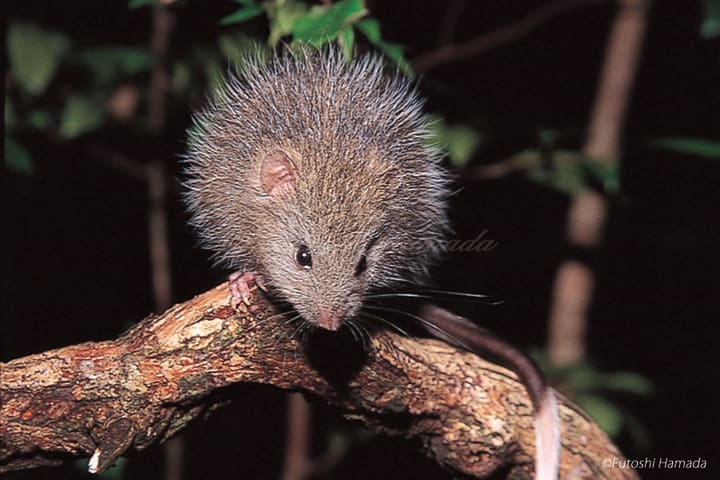
The Ryukyu Long-haired Rat (Diplothrix legata) is a species of rodent that belongs to the family Muridae. It is endemic to the Ryukyu Islands, a chain of islands in southern Japan. The species is known for its unique and distinctive long, shaggy fur, which sets it apart from other rats.
Here are some full details about the Ryukyu Long-haired Rat:
Physical Description:
The Ryukyu Long-haired Rat is a medium-sized rodent with a slender body and a long, bushy tail. It measures around 12 to 17 centimeters (4.7 to 6.7 inches) in length, excluding the tail. The tail itself can grow up to 15 centimeters (5.9 inches) long. The rat has large, rounded ears and relatively small eyes. Its fur is the most remarkable feature, consisting of long, dense, and shaggy hair that is usually grayish-brown in color. The hair on the back often has a darker shade compared to the underparts.
Habitat:
This species is endemic to the Ryukyu Islands of Japan, including Okinawa, Amami, and Tokunoshima. It primarily inhabits forests and woodlands, preferring areas with dense vegetation and abundant ground cover. The rats are skilled climbers and can be found in trees and shrubs as well. They construct nests in hollow trees, leaf litter, or among rocks.
Behavior and Diet:
Ryukyu Long-haired Rats are primarily nocturnal, meaning they are most active during the night. They are agile and quick, using their slender bodies to navigate through the vegetation with ease. These rats are known to be excellent climbers, enabling them to access different food sources and find shelter. Their diet mainly consists of plant materials such as fruits, seeds, nuts, and leaves. They also feed on insects, small invertebrates, and occasionally, carrion.
Reproduction:
Breeding patterns and reproductive behavior of the Ryukyu Long-haired Rat are not extensively studied. However, it is believed that they have a similar reproductive strategy to other murid rodents. Females are likely to have multiple litters per year, with each litter consisting of several young. The gestation period lasts for around three weeks, and the young are born relatively undeveloped, relying on their mother for nourishment and protection.
Conservation Status:
The conservation status of the Ryukyu Long-haired Rat is currently categorized as "Least Concern" by the International Union for Conservation of Nature (IUCN). Despite this, the species faces certain threats, mainly due to habitat loss and fragmentation caused by human activities, such as deforestation and urbanization. Additionally, the introduction of non-native predators to the Ryukyu Islands poses a risk to the rat's survival. Conservation efforts focus on preserving and restoring suitable habitats and raising awareness about the importance of protecting this unique and endemic species.
Overall, the Ryukyu Long-haired Rat (Diplothrix legata) is a fascinating rodent species with its distinctive appearance and habitat preferences. Its presence in the Ryukyu Islands adds to the biodiversity of the region, highlighting the need for conservation efforts to ensure its long-term survival.
5., okyo Daruma Pond Frog (Rana porosa porosa):

The Japanese Brown Frog, scientifically known as Rana porosa porosa, is a species of true frog belonging to the family Ranidae. It is commonly found in various parts of East Asia, including Japan, Russia, Korea, and China. The species is also known as the Amur Brown Frog, reflecting its presence in the Amur River region.
Physical Description:
The Japanese Brown Frog is a medium-sized frog with a robust body structure. Adult males typically measure between 5 to 8 centimeters (2 to 3.1 inches) in snout-vent length, while females tend to be slightly larger, reaching 6 to 9 centimeters (2.4 to 3.5 inches). The coloration of the frog can vary depending on its surroundings, but it generally displays shades of brown, olive, or gray. The skin is rough, and the back may exhibit dark spots or irregular markings. The underside is usually lighter in color.
Habitat and Distribution:
Rana porosa porosa inhabits a range of habitats, including forests, grasslands, marshes, and wetlands. It prefers areas near freshwater bodies such as ponds, lakes, rivers, and swamps. The species is known for its adaptability and can tolerate a wide range of temperatures. Its distribution encompasses various regions in East Asia, with populations present in Japan, the Russian Far East, the Korean Peninsula, and northeastern China.
Behavior and Diet:
These frogs are primarily active during the warmer months, from spring to early autumn. They are excellent swimmers and are well adapted to aquatic environments. The Japanese Brown Frog is known for its distinct call, which resembles a "kurr-kurr" sound. Males vocalize to attract females during the breeding season, creating a chorus of calls in breeding sites.
As for their diet, the Japanese Brown Frogs are opportunistic feeders. They consume a variety of invertebrates, including insects, spiders, snails, and worms. Tadpoles of this species feed on plant matter and detritus in the water.
Reproduction:
Breeding in Rana porosa porosa typically occurs during the spring and early summer. Males gather at breeding sites, such as ponds or slow-moving streams, and produce their distinctive calls to attract females. After mating, the female lays her eggs in small clusters, attaching them to aquatic vegetation or debris. The eggs hatch into tadpoles, which undergo a metamorphosis process to become adult frogs.
Conservation Status:
The Japanese Brown Frog (Rana porosa porosa) is generally considered to be of least concern in terms of conservation status. It has a wide distribution and adaptable nature, which has likely contributed to its relatively stable population. However, like many amphibian species, it can be impacted by habitat degradation, pollution, and the introduction of invasive species. Continued monitoring and conservation efforts are necessary to safeguard their populations and ensure the preservation of their habitats.
Please note that if you were referring to a different species or had specific information about the "Okyo Daruma Pond Frog," please provide more details, and I'll be happy to assist you further.
6., Japanese Crested Ibis (Nipponia nippon):
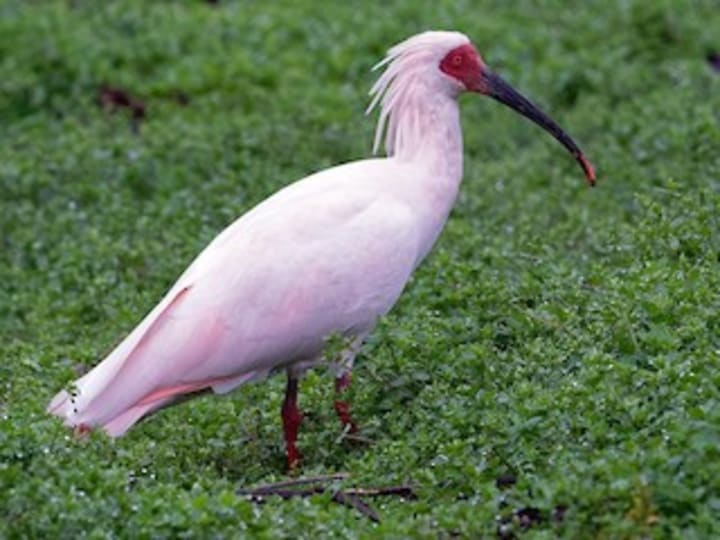
The Japanese Crested Ibis (Nipponia nippon), also known as the Toki in Japan, is a critically endangered bird species that is native to East Asia. It is one of the most iconic and culturally significant birds in Japan. Here are full details about the Japanese Crested Ibis:
Physical Description:
The Japanese Crested Ibis is a large wading bird with distinct features. It has a white plumage with a reddish-brown crest on its head, giving it its name. The bird has a long, slender bill that curves downward, which it uses to forage for food in shallow water. It has long, thin legs that are black in color. Adults typically measure around 75 to 80 centimeters (30 to 32 inches) in length and weigh approximately 2.3 to 2.9 kilograms (5.1 to 6.4 pounds).
Habitat and Distribution:
Historically, the Japanese Crested Ibis was found across East Asia, including Japan, China, Korea, and Russia. However, due to significant population declines, it is now primarily restricted to Japan. The species prefers freshwater habitats, such as wetlands, marshes, and rivers with dense vegetation and abundant food sources.
Behavior and Diet:
Japanese Crested Ibises are generally solitary or found in small groups. They are diurnal birds, being most active during the day. They are known for their elegant and graceful flight, with slow wingbeats and a distinctive gliding pattern. These ibises feed mainly on aquatic invertebrates, including crustaceans, insects, fish, and amphibians. They use their long bill to probe in the mud or shallow water to find their prey.
Reproduction:
Breeding season for the Japanese Crested Ibis usually occurs from March to May. The species typically forms monogamous pairs. The ibises build nests in trees, often near water bodies. The female lays a clutch of 2 to 4 eggs, which both parents take turns incubating for about 28 to 29 days. After hatching, the chicks are cared for by both parents and fledge after about 40 to 45 days.
Conservation Status:
The Japanese Crested Ibis is classified as critically endangered by the International Union for Conservation of Nature (IUCN). It has faced significant population declines due to habitat loss, hunting, and the use of pesticides. By the mid-20th century, the species was thought to be extinct in Japan. However, a small population was discovered in China, and efforts to reintroduce the species in Japan have been ongoing since the 1990s.
Conservation efforts include captive breeding programs, habitat restoration, and public awareness campaigns. The population has shown some signs of recovery, but it remains highly vulnerable. The Japanese government, along with various conservation organizations, continues to work towards the recovery and conservation of this iconic bird.
The Japanese Crested Ibis, with its cultural significance and historical importance, serves as a symbol of conservation efforts and the need to protect biodiversity and fragile ecosystems
7., Amami Woodcock (Scolopax mira):
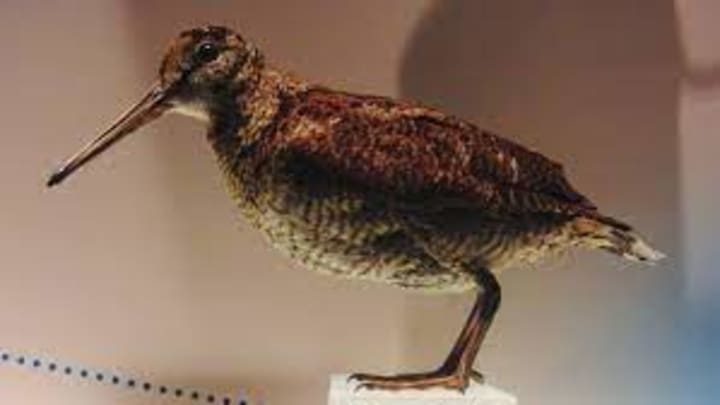
The Eurasian Woodcock (Scolopax rusticola) is a migratory bird that belongs to the family Scolopacidae. Here are some full details about the Eurasian Woodcock:
Physical Description:
The Eurasian Woodcock is a medium-sized wading bird, measuring around 33 to 38 centimeters (13 to 15 inches) in length. It has a plump body with short legs and a long, straight bill. The bird's plumage is highly camouflaged, featuring intricate patterns of browns, grays, and blacks, which allow it to blend in with its woodland habitat. The most distinctive feature of the woodcock is its large, round head with large, dark eyes positioned high on the skull.
Habitat and Distribution:
The Eurasian Woodcock is widely distributed across temperate regions of Europe, Asia, and North Africa. It can be found in various habitats, but it is primarily associated with damp woodlands, including deciduous and coniferous forests. During migration, the woodcock can cover significant distances, and it may also be found in open fields or wetlands temporarily.
Behavior and Diet:
Woodcocks are primarily nocturnal and are known for their unique feeding behavior. They use their long bill to probe the soft ground for earthworms, insects, spiders, and other invertebrates, which make up the majority of their diet. They have a specialized sensory organ located at the tip of their bill that enables them to detect prey underground.
During the breeding season, male woodcocks perform elaborate courtship displays to attract females. These displays involve flight patterns, aerial displays, and vocalizations. After mating, the female lays a clutch of 3 to 4 eggs in a nest on the ground, usually concealed among vegetation. The incubation period lasts for about 21 to 24 days, and the chicks leave the nest shortly after hatching, being able to feed themselves.
Conservation Status:
The Eurasian Woodcock is currently classified as a species of least concern by the International Union for Conservation of Nature (IUCN). While its populations can experience fluctuations due to habitat loss and degradation, the species is widespread and has a large global population. However, local populations may be affected by changes in land use, such as deforestation and intensification of agriculture, which can reduce suitable nesting and foraging areas.
Woodcocks benefit from the establishment of protected areas, habitat conservation, and sustainable land management practices. Monitoring population trends and addressing potential threats are essential to ensure the long-term conservation of these birds.
Please note that if you were referring to a different species or had specific information about the "Amami Woodcock" (Scolopax mira), please provide more details, and I'll do my best to assist you further.
8., Japanese Giant Salamander (Andrias japonicus):
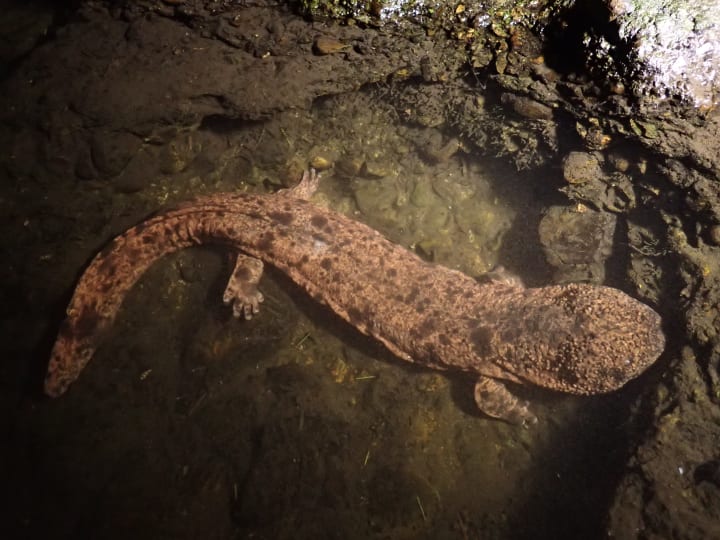
The Japanese Giant Salamander, scientifically known as Andrias japonicus, is a remarkable amphibian species that is native to Japan. It is the largest salamander species in the world and is highly regarded for its unique appearance and ecological significance. Here are the full details about the Japanese Giant Salamander:
Appearance: The Japanese Giant Salamander has a robust and elongated body, which can reach an impressive length of up to 1.5 meters (5 feet). It has a large, flattened head with small eyes and a wide mouth. Its body is covered in wrinkled, slimy skin, which is usually dark brown or grayish in color, providing excellent camouflage in its natural habitat.
Habitat: These salamanders are primarily found in the clear, fast-flowing streams and rivers of Japan. They inhabit cool, well-oxygenated water bodies with rocky substrates, submerged caves, and crevices. Japanese Giant Salamanders are most commonly found in the mountainous regions of western Honshu, Shikoku, and Kyushu islands.
Diet: These salamanders are nocturnal and mainly carnivorous, feeding on a variety of prey including small fish, insects, crustaceans, and amphibians. Their diet mainly consists of aquatic invertebrates, but larger individuals have been known to consume small mammals or birds that happen to fall into the water.
Life Cycle: The Japanese Giant Salamander undergoes a complex life cycle. After mating, the female lays a clutch of around 400 to 500 eggs, which are fertilized externally by the male. The eggs are then guarded by the male until they hatch, which takes approximately 50 to 70 days. The larvae have external gills and are fully aquatic, feeding on small invertebrates. As they grow, they undergo metamorphosis, losing their gills and transitioning to a more terrestrial lifestyle.
Conservation Status: The Japanese Giant Salamander is listed as near threatened by the International Union for Conservation of Nature (IUCN). The species faces several threats, including habitat loss, water pollution, and overcollection for the pet trade or as a delicacy. Efforts are being made to conserve the species, such as the establishment of protected areas and breeding programs.
Ecological Importance: Japanese Giant Salamanders play a crucial role in their ecosystems as both predators and prey. They help control populations of invertebrates and small vertebrates, contributing to the balance of aquatic ecosystems. Their presence is often an indicator of healthy and clean water bodies.
Cultural Significance: The Japanese Giant Salamander holds a special place in Japanese folklore and culture. It is often considered a sacred creature and has been featured in various legends and stories. Due to its unique appearance and biological significance, it has become a popular attraction in zoos and aquariums, both in Japan and around the world.
The Japanese Giant Salamander, with its impressive size, fascinating life cycle, and ecological importance, continues to captivate the interest of researchers, conservationists, and nature enthusiasts worldwide. Efforts to protect and preserve this magnificent species are crucial to ensure its long-term survival in its natural habitat.
9., Dugong (Dugong dugon):

The Dugong, scientific name Dugong dugon, is a fascinating marine mammal commonly known as the "sea cow." It is the only living species in the family Dugongidae and is closely related to manatees. Dugongs are known for their unique appearance and are famous for their role as gentle herbivores in the world's tropical coastal waters. Here are the full details about the Dugong:
Appearance: Dugongs have a robust and streamlined body, adapted for a marine lifestyle. They can grow up to 3 meters (10 feet) in length and weigh around 400 to 600 kilograms (880 to 1,320 pounds). They have a fusiform body shape with a tapered tail fluke and paddle-like forelimbs, which they use for propulsion. Their skin is thick and wrinkled, and their coloration varies from light to dark gray.
Distribution: Dugongs are found in warm coastal waters of the Indo-Pacific region, including the Red Sea, the Persian Gulf, the Indian Ocean, and the western Pacific Ocean. They inhabit shallow, protected areas such as bays, lagoons, and coral reefs, where seagrass beds are abundant.
Diet: Dugongs are herbivores, feeding exclusively on seagrass. They are highly specialized grazers and have a split upper lip and a strong muscular snout that they use to uproot seagrass from the ocean floor. They primarily feed on species of seagrass such as Halophila, Halodule, and Thalassia.
Behavior: Dugongs are generally solitary animals but can be seen in small groups or pairs, especially during mating or when a female is accompanied by her calf. They are slow swimmers and spend most of their time feeding, often consuming large quantities of seagrass to meet their energy requirements. They are known for their ability to stay submerged for up to six minutes before resurfacing for a breath.
Reproduction: Dugongs have a slow reproductive rate. Mating usually occurs underwater, and after a gestation period of around 13 to 15 months, a single calf is born. The calf is approximately one meter (3.3 feet) long and is nursed by the mother for about 18 months. Female dugongs typically have a calving interval of three to seven years.
Conservation Status: The Dugong is listed as vulnerable by the International Union for Conservation of Nature (IUCN). The species faces numerous threats, including habitat degradation and loss due to coastal development, pollution, entanglement in fishing nets, and hunting for its meat, oil, and bones. Conservation efforts focus on protecting critical habitats, implementing sustainable fishing practices, and raising awareness about the importance of conserving this unique marine mammal.
Ecological Importance: Dugongs are crucial for the health of seagrass ecosystems. By consuming seagrass, they help maintain the balance of these habitats, promoting new growth and preventing overgrowth. Additionally, their feeding activities create channels and trails that improve water circulation and nutrient distribution.
The Dugong, with its gentle nature and vital ecological role, holds significance in the marine environment. Its conservation is essential not only for the survival of the species but also for the health and balance of coastal ecosystems. Efforts to protect their habitats and mitigate human-induced threats are crucial to ensure the long-term survival of these magnificent marine creatures.
10., Red-crowned Crane (Grus japonensis):
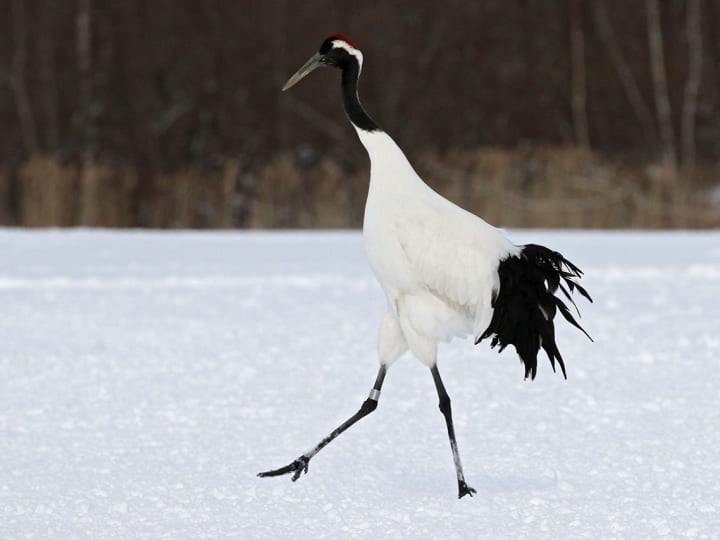
The Red-crowned Crane, scientifically known as Grus japonensis, is a magnificent and endangered bird species native to East Asia. It is one of the rarest and most iconic crane species in the world. Here are the full details about the Red-crowned Crane:
Appearance: The Red-crowned Crane is a large bird with a height ranging from 140 to 160 centimeters (55 to 63 inches) and a wingspan of approximately 230 to 250 centimeters (90 to 98 inches). It has a predominantly white plumage, with black primary and secondary feathers. The crown of the crane is covered with bare red skin, which gives the species its name. It also has a patch of black feathers on its cheeks and a long, slender neck.
Distribution: The Red-crowned Crane is native to East Asia and has a restricted distribution. It is primarily found in three main regions: the Amur River basin in Russia, northeastern China, and Hokkaido Island in Japan. During the breeding season, the cranes inhabit wetlands, marshes, and riverine habitats, while they migrate to agricultural fields and coastal areas during the non-breeding season.
Diet: Red-crowned Cranes are omnivorous, but their diet mainly consists of plant matter. They feed on a variety of items, including aquatic plants, tubers, grains, berries, and invertebrates such as insects, mollusks, and small crustaceans. They use their long beaks to forage in wetlands and shallow water, probing the mud and vegetation for food.
Behavior: These cranes are known for their graceful courtship displays, which involve elaborate dances, head-bobbing, and calling. They are monogamous birds and form lifelong pair bonds. Red-crowned Cranes are highly territorial, and their loud bugling calls are used for communication and to establish and defend their breeding territories.
Conservation Status: The Red-crowned Crane is classified as endangered by the International Union for Conservation of Nature (IUCN). The species has experienced significant population declines due to habitat loss, degradation of wetlands, hunting, and poaching. Conservation efforts focus on habitat protection, captive breeding and reintroduction programs, and public awareness campaigns to mitigate threats and promote the conservation of this iconic bird.
Cultural Significance: The Red-crowned Crane holds great cultural significance in the countries where it is found. It is considered a symbol of longevity, good fortune, and fidelity in various Asian cultures, including Japan, China, and Korea. The crane is often depicted in traditional artworks, folklore, and ceremonies, representing grace, beauty, and harmony with nature.
Conservation Efforts: Various conservation initiatives are in place to protect the Red-crowned Crane. Protected areas, such as national parks and nature reserves, have been established to safeguard their habitats. Conservation organizations work to raise awareness, conduct scientific research, and implement measures to reduce human impacts on their populations.
The Red-crowned Crane, with its striking appearance and cultural significance, serves as a flagship species for the conservation of wetland ecosystems. Preserving their habitats and addressing the threats they face is vital to ensure the survival of this majestic bird and the conservation of the diverse ecosystems it inhabits.
About the Creator
Enjoyed the story? Support the Creator.
Subscribe for free to receive all their stories in your feed. You could also pledge your support or give them a one-off tip, letting them know you appreciate their work.






Comments
There are no comments for this story
Be the first to respond and start the conversation.